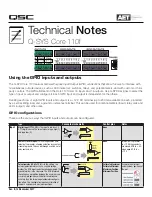
4
Smoke exhaust fan control system –
EVS
Installation and Operating Instructions
4
EN
3 .1 Installation
Basic information
The following instructions must be observed prior to installation:
–
The EVS must be installed as close as possible to the corresponding smoke exhaust fan, but outside the smoke
exhaust area.
–
The EVS must be accessible via escape and rescue routes.
–
The power supply for the EVS and the smoke exhaust fan must be installed to maintain functionality and it must be
connected directly to the low-voltage main power distribution system.
–
If the EVS cannot be seen from the smoke exhaust fan, an isolator must be installed in the immediate vicinity of the
smoke exhaust fan for maintenance and repair work.
EVS installation:
–
Fix the EVS to the wall with suitable screws through the provided holes in the housing.
–
Ensure that the housing cover is correctly mounted and secure.
3 .2 Electrical connection
3 .2 .1 Connection options
Only accessory components provided by Helios must be used. The connection of third-party products is expressly prohibited!
Reliable system activation in case of fire and interference-free operation cannot be guaranteed if accessory components which
are not approved by Helios are used.
The following accessory components can be connected to the EVS (see Fig. 1):
Fireman‘s switch (FWS)
The fireman‘s switch has absolute priority. All other control components are subordinate. Up to 6 fireman‘s switches can be ope-
rated equally. The system status is displayed via LED signal lights. The detector circuit is monitored for wire breakages and short
circuits. A fault signal is issued in case of an interruption of the connection cable or short circuit.
Pushbutton alarm (DKM)
Up to 20 pushbutton alarms can be connected to the EVS in a detector line as standard. If an alarm is activated, the smoke extrac-
tion mode is triggered and the alarm is stored. The detector circuit is monitored for wire breakages and short circuits. A fault signal
is issued in case of an interruption of the connection cable or short circuit. The alarm can be reset directly on the pushbutton alarm.
The alarm is reset by the preceding resetting of the triggered pushbutton alarm and subsequent resetting using the “system reset”.
When connecting pushbutton alarms to the EVS, the position of the slide switch should be taken into account (can be used as a
switch or button).
Smoke detector (RMR)
Up to 60 smoke detectors can be connected to the EVS in a detector line as standard. If an alarm is activated, the smoke extraction
mode is triggered. The detector circuit is monitored for short circuits, wire breakages and missing detector deployment. In case of
an interruption of the connection cable, missing detector deployment or short circuit, a fault signal is issued. The alarm is self-hol-
ding. The alarm is reset using the “system reset” function or by pressing the “reset button” on the pushbutton alarm for 1 second.
Weekly autotimer (WSUP)
One weekly autotimer (EVS-W, EVS-D, EVS-SD) or two weekly autotimers (EVS-DA) can be connected to the EVS as standard for
the automatic control of the extract ventilation function.
Fire alarm system (BMA)
If an alarm is triggered by the fire alarm system or an interruption of the connection cable, the smoke extraction mode is triggered.
The detector circuit is monitored for short circuits. In case of a short circuit, a fault signal is issued. The triggering can be stored or
self-reset. The setting is adjust via a selector switch on the control unit.
Isolator switch / external signal input (RS)
With regard to ventilation mode, the fan is deactivated and a fault signal is issued in case of deactivation using the isolator switch.
With regard to smoke extraction mode, a fault signal is issued but the fan is not deactivated by the EVS. The isolator switch must
IMPORTANT
+
Isolator
switch
Fault
- pot.fre
e
.
c
onta
c
t
-
Flash light
Smoke extr.
-
pot.fre
e
.
c
onta
c
t
-
Flash light
-
Flash light siren
-
Warning siren
Motor prot.
TK/KL
(
bridged in case
of fire)
Weekly
autotimer
Smoke
detector
Pushbutton
alarm
Fireman's
alarm
Fire alarm
system
Fan
damper
Fig . 1
Summary of Contents for EVS Series
Page 9: ...7 Entrauchungsventilatoren Steuerung EVS Montage und Betriebsvorschrift EVS D DE ...
Page 10: ...8 Entrauchungsventilatoren Steuerung EVS Montage und Betriebsvorschrift EVS D DE ...
Page 11: ...9 Entrauchungsventilatoren Steuerung EVS Montage und Betriebsvorschrift EVS D DE ...
Page 12: ...10 Entrauchungsventilatoren Steuerung EVS Montage und Betriebsvorschrift EVS D DE ...
Page 13: ...11 Entrauchungsventilatoren Steuerung EVS Montage und Betriebsvorschrift EVS SD DE ...
Page 14: ...12 Entrauchungsventilatoren Steuerung EVS Montage und Betriebsvorschrift EVS SD DE ...
Page 15: ...13 Entrauchungsventilatoren Steuerung EVS Montage und Betriebsvorschrift EVS SD DE ...
Page 16: ...14 Entrauchungsventilatoren Steuerung EVS Montage und Betriebsvorschrift EVS SD DE ...
Page 17: ...15 Entrauchungsventilatoren Steuerung EVS Montage und Betriebsvorschrift EVS DA DE ...
Page 18: ...16 Entrauchungsventilatoren Steuerung EVS Montage und Betriebsvorschrift EVS DA DE ...
Page 19: ...17 Entrauchungsventilatoren Steuerung EVS Montage und Betriebsvorschrift EVS DA DE ...
Page 20: ...18 Entrauchungsventilatoren Steuerung EVS Montage und Betriebsvorschrift EVS DA DE ...
Page 21: ...19 Entrauchungsventilatoren Steuerung EVS Montage und Betriebsvorschrift EVS W DE ...
Page 22: ...20 Entrauchungsventilatoren Steuerung EVS Montage und Betriebsvorschrift EVS W DE ...
Page 23: ...21 Entrauchungsventilatoren Steuerung EVS Montage und Betriebsvorschrift EVS W DE ...
Page 62: ...30 Smoke exhaust fan control system EVS Installation and Operating Instructions ...
Page 63: ...31 Smoke exhaust fan control system EVS Installation and Operating Instructions ...
















































